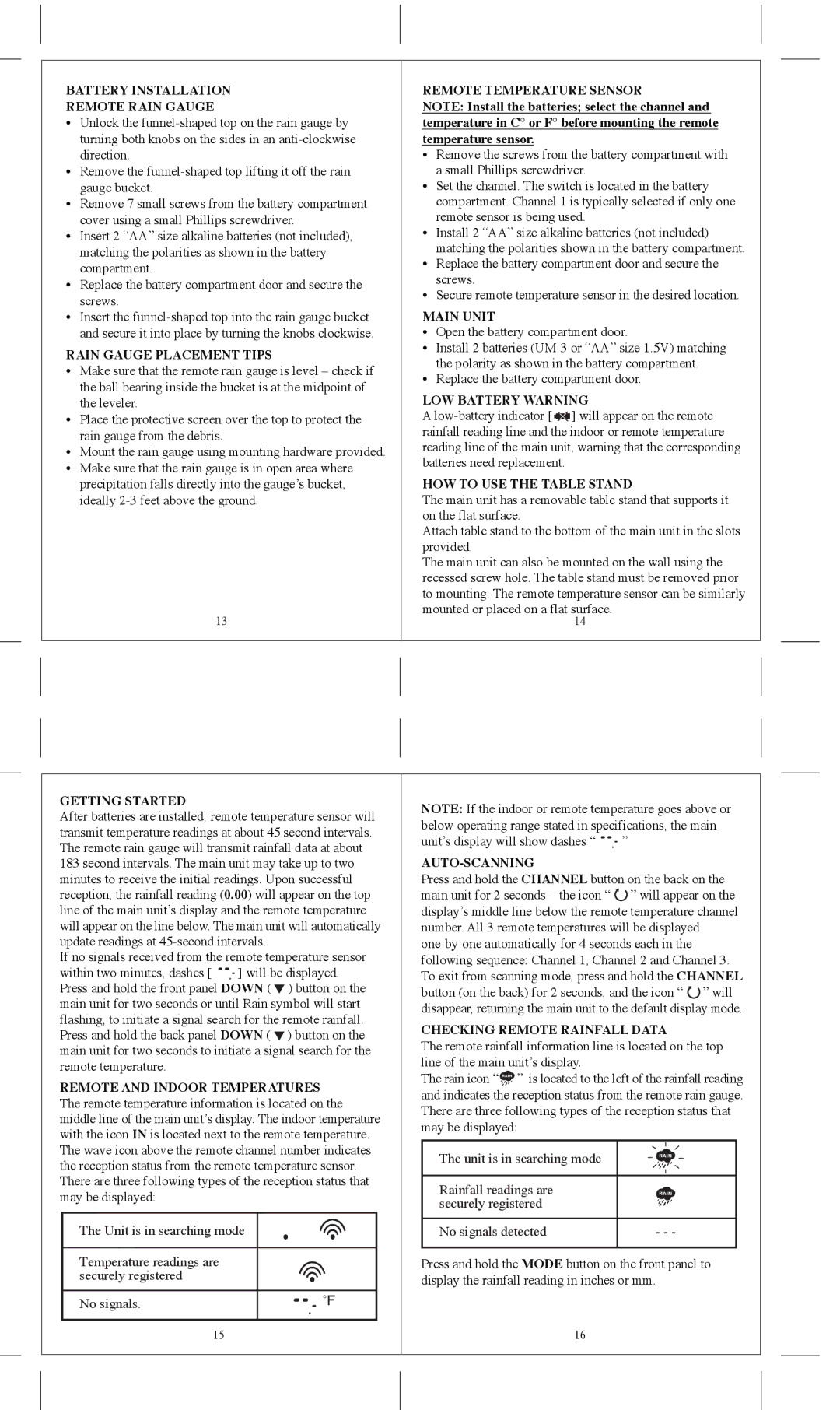
BATTERY INSTALLATION
REMOTE RAIN GAUGE
•Unlock the
•Remove the
•Remove 7 small screws from the battery compartment cover using a small Phillips screwdriver.
•Insert 2 “AA” size alkaline batteries (not included), matching the polarities as shown in the battery compartment.
•Replace the battery compartment door and secure the screws.
•Insert the
RAIN GAUGE PLACEMENT TIPS
•Make sure that the remote rain gauge is level – check if the ball bearing inside the bucket is at the midpoint of the leveler.
•Place the protective screen over the top to protect the rain gauge from the debris.
•Mount the rain gauge using mounting hardware provided.
•Make sure that the rain gauge is in open area where precipitation falls directly into the gauge’s bucket, ideally
13
REMOTE TEMPERATURE SENSOR
NOTE: Install the batteries; select the channel and temperature in C° or F° before mounting the remote temperature sensor.
•Remove the screws from the battery compartment with a small Phillips screwdriver.
•Set the channel. The switch is located in the battery compartment. Channel 1 is typically selected if only one remote sensor is being used.
•Install 2 “AA” size alkaline batteries (not included) matching the polarities shown in the battery compartment.
•Replace the battery compartment door and secure the screws.
•Secure remote temperature sensor in the desired location.
MAIN UNIT
•Open the battery compartment door.
•Install 2 batteries
•Replace the battery compartment door.
LOW BATTERY WARNING
A ![]() ] will appear on the remote rainfall reading line and the indoor or remote temperature reading line of the main unit, warning that the corresponding batteries need replacement.
] will appear on the remote rainfall reading line and the indoor or remote temperature reading line of the main unit, warning that the corresponding batteries need replacement.
HOW TO USE THE TABLE STAND
The main unit has a removable table stand that supports it on the flat surface.
Attach table stand to the bottom of the main unit in the slots provided.
The main unit can also be mounted on the wall using the recessed screw hole. The table stand must be removed prior to mounting. The remote temperature sensor can be similarly mounted or placed on a flat surface.
14
GETTING STARTED
After batteries are installed; remote temperature sensor will transmit temperature readings at about 45 second intervals. The remote rain gauge will transmit rainfall data at about 183 second intervals. The main unit may take up to two minutes to receive the initial readings. Upon successful reception, the rainfall reading (0.00) will appear on the top line of the main unit’s display and the remote temperature will appear on the line below. The main unit will automatically update readings at
If no signals received from the remote temperature sensor within two minutes, dashes [ ![]()
![]()
![]() ] will be displayed. Press and hold the front panel DOWN (
] will be displayed. Press and hold the front panel DOWN ( ![]() ) button on the main unit for two seconds or until Rain symbol will start flashing, to initiate a signal search for the remote rainfall. Press and hold the back panel DOWN (
) button on the main unit for two seconds or until Rain symbol will start flashing, to initiate a signal search for the remote rainfall. Press and hold the back panel DOWN ( ![]() ) button on the main unit for two seconds to initiate a signal search for the remote temperature.
) button on the main unit for two seconds to initiate a signal search for the remote temperature.
REMOTE AND INDOOR TEMPERATURES The remote temperature information is located on the middle line of the main unit’s display. The indoor temperature with the icon IN is located next to the remote temperature. The wave icon above the remote channel number indicates the reception status from the remote temperature sensor. There are three following types of the reception status that may be displayed:
The Unit is in searching mode
Temperature readings are securely registered
No signals. | ˚F |
15
NOTE: If the indoor or remote temperature goes above or below operating range stated in specifications, the main unit’s display will show dashes “ ![]()
![]()
![]() ”
”
AUTO-SCANNING
Press and hold the CHANNEL button on the back on the main unit for 2 seconds – the icon “ ![]() ” will appear on the display’s middle line below the remote temperature channel number. All 3 remote temperatures will be displayed
” will appear on the display’s middle line below the remote temperature channel number. All 3 remote temperatures will be displayed ![]() ” will disappear, returning the main unit to the default display mode.
” will disappear, returning the main unit to the default display mode.
CHECKING REMOTE RAINFALL DATA
The remote rainfall information line is located on the top line of the main unit’s display.
The rain icon “![]() ” is located to the left of the rainfall reading and indicates the reception status from the remote rain gauge. There are three following types of the reception status that may be displayed:
” is located to the left of the rainfall reading and indicates the reception status from the remote rain gauge. There are three following types of the reception status that may be displayed:
The unit is in searching mode
Rainfall readings are securely registered
No signals detected | - - - |
Press and hold the MODE button on the front panel to display the rainfall reading in inches or mm.
16
